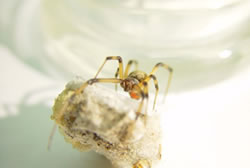Read this article, then answer the questions below.
Tropical ‘Brown Widow’ Spider, New to Los
Angeles
Captured In Torrance; On Display at Museum
Discovery Part of Ongoing L.A. Spider Survey
By the Natural History Museum of Los Angeles County
 LOS ANGELES, Feb. 3, 2003 - A tropical "Brown Widow" spider, new to the Los Angeles area, has been captured as part of the Natural History Museum of Los Angeles County’s ongoing Spider Survey. The live, venomous spider, along with its egg sac containing up to 100 baby spiders, is currently on public display in the Museum’s Insect Zoo.
LOS ANGELES, Feb. 3, 2003 - A tropical "Brown Widow" spider, new to the Los Angeles area, has been captured as part of the Natural History Museum of Los Angeles County’s ongoing Spider Survey. The live, venomous spider, along with its egg sac containing up to 100 baby spiders, is currently on public display in the Museum’s Insect Zoo.
Brian Brown, associate curator of entomology, said this spider has not been found previously in the Los Angeles area. "The Brown Widow probably originated in Africa, but has been introduced into the tropics almost worldwide," he said. According to Brown, one of the many ways the spider could have made it to the Southland was through commercial imports of plants, flowers, food or furniture.
The Brown Widow is so rare to the Los Angeles area that this is the first one out of 3,000 spiders so far to be collected as part of the Museum’s Spider Survey. The survey began last Spring to discover which types of spiders are found in the greater Los Angeles basin. "This is the most unusual specimen we’ve found through the survey so far," Brown said.
It was a 4th-grade student from Van Deene Elementary School in Torrance, while on a Honda Earth Odyssey Program field trip run by the Museum, who discovered the spider.
The program is designed to introduce elementary school children to biodiversity and build environmental awareness. The children had been briefed about spiders before the field trip onto the school grounds. The student recognized the spider as being of particular interest and pointed it out to Beth Nordeen, a Museum outreach educator.
"The spider was inside a rolled-up leaf of a Bird of Paradise plant on the school grounds," Nordeen said. "It was in a tangled web along with an egg sac." Using a stick, she tugged on the web, until she was able to place the spider and its egg sac into a plastic bottle with a cap. Nordeen added that you never want to handle any spider with your bare hands.

The scientific name for the Brown Widow is Lactrodectus geometricus. There are about 30 described widow species including Black Widows, Red Widows, and the Brown Widows - the Black Widow being the most common of the widow family in the Los Angeles area. A Brown Widow spider can grow to one-and-a-half inches long. It has an orange-to-yellow hourglass design on its underside, as opposed to the familiar red hourglass design on the Black Widow.
"The good news is that Brown Widows are not as aggressive as the Black Widows. The bad news is that they are twice as poisonous," Brown said. "Brown Widows will not attack if they are not bothered or made to feel threatened." He added that a Brown Widow will more than likely "play possum" if confronted by a potential enemy.
Most spiders in Southern California are unable to puncture human skin and if they do, their venom would not be harmful to humans. There are three known species in Los Angeles that pose a threat to humans - the Black Widow, Violin spider, and now the Brown Widow. The Violin spider, often misidentified as the Brown Recluse, is a fast little spider measuring only a half-inch as an adult. In Southern California, it has only been found in only a few areas of Los Angeles County and the Inland Empire. If bitten by any one of these spiders, seek medical assistance.
|